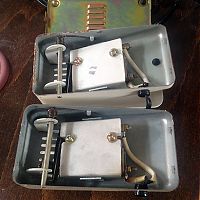My main sewing machine is a JoAnn Sonata, and it has a bit of a history. It’s technically a vintage machine, I think, having been made in the early 1980s and then promptly forgotten by the entire world. Every now and then I get an email from someone who bought one at a yard sale, thanking me profusely for scanning and uploading the user manual, but for years the only Google hits for it were ones I’d written myself.

My machine, photographed in 2006
To complicate matters even further, my machine began life as my sister-in-law’s grandmother’s machine, which was gifted to me well over a decade ago when my mom brought it over as checked luggage on a flight from the States. So on top of being some random, vintage brand no one’s ever heard of, it’s also the wrong voltage (I run it through a voltage converter).
Considering the sheer volume of use it sees, the machine does so well, and I have no intention of ever replacing it so long as I can keep repairing it. I mean, I clean it fairly regularly, but I hardly ever oil it, and it only went in for its first ever service (during my tenure, anyway) last winter when the foot pedal stopped responding. My man at Maury Sewing was able to repair the foot pedal then, but advised that if it failed again, I should buy a replacement pedal from the States and just swap out the plug end (he looked into replacing the motor with a 220v one but couldn’t find one to fit the body on short notice).
The repairs lasted a good six months, but again recently, I found myself having to pump the pedal to get it to respond, and even then, it’d only go at maximum speed which isn’t exactly ideal. So I hunted on US eBay and found a really similar-looking vintage, metal food pedal in 110v wiring, with the thought of recruiting James to rewire the old plug end onto the new-to-me pedal.

The eBay replacement (top) and my original (bottom)
But our friend Alex happened to be visiting after it arrived, and said he’d be happy to have a look. He grabbed a screwdriver and opened them up and to our amazement, the pedals were actually identical inside!
He started to take them apart and check the voltage and everything, but then realised it was going to be a bigger task than he’d thought, so agreed instead to take it in to his work (he’s the one who works at “the death ray” we toured last Fall) where they had better equipment, and he’d post them back to me.
A few days later the text messages started arriving – apparently the in-house electronics technician came over to have a look, started taking it apart, and got really interested in the vintage electronics! Instead of just swapping the plug end so the eBay one would fit into my machine, they opted instead to repair my original pedal using the eBay one as spare parts, which was much more fun!
Apart from not having an Earth because it’s US wiring (in the UK, the outside chassis would be connected to Earth to ground it, but US plugs don’t do that), they’ve said it’s perfectly up to safety specs (the voltage converter I use has it’s own fuses), and the slight charring we saw on the wires’ insulation was most likely caused by the earlier repair soldering and not any electrical fault! Phew!
Apparently the coolest thing about the pedals is that they have about 100 or so little carbon discs inside (see photo above) – as the pedal is pressed, the stack of discs is squashed down, which changes their resistance! The technician had never seen anything like this before, and was very pleased to have worked on it. A few of the discs in my pedal were singed and a few were shattered, so the main repair work just consisted of replacing the discs with ones from the eBay pedal, and in one case, a brass washer so that the right space is still maintained. How cool is that?
And to answer your question – it sews like a dream now! It’s purring like a kitten in a way I’ve not seen in ten years. And more importantly, it’s allowed me to keep sewing on my machine which I love, otherwise works great, and has a wonderful history. A new, plastic replacement machine couldn’t have come close!



